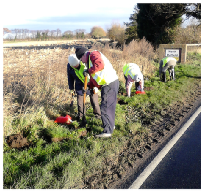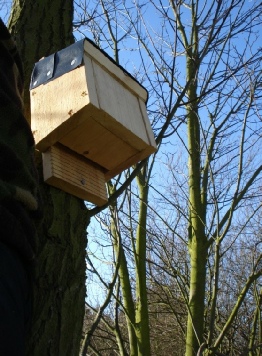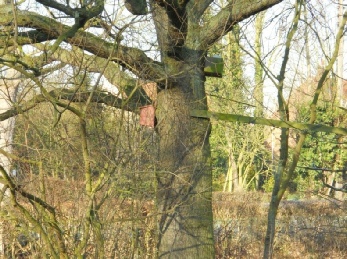


FLORA AND FAUNA
ROADSIDE VERGES
Conservation has always been at the heart of the aims of the Society from its conception in 1983. Over the years bat boxes, owl and garden bird nesting boxes have been erected and attempts made to make the village welcoming to wildlife and people.
One area that had received very little attention were the roadside verges both within and on the approach roads into the village. With the exception of a long-
The matter was placed before the Parish Council who expressed considerable interest and a discussion took place concerning grass-
The Society contacted the Biodiversity Officer of the NYCC who was both supportive and helpful and forwarded a copy of the document about the subject (Appendix A).

Bulb planting on the A163
This document informed us that verges became less species-
grass-
A site visit was arranged with all interested parties looking at the verges and a number of options were discussed. It was resolved to contact NYCC with an attempt to restrict the cutter size and frequency of cutting of the contractor, Ways of removing the grass cuttings were also discussed.
A member of the Society contacted Dr Margaret Atherden, a retired lecturer from York, who offered to visit in the early summer to do a species count and make recommendations.
Dr Atherden attended on 15th June 2011 and a party of Parish Councillors and History Society members conducted a survey of the verges on the A163, Menthorpe Lane, Cornelius Causeway and Skipwith Road (See Appendix B) During this meeting it transpired that the cutting the verges in Menthorpe Lane was carried out by David Simpson in order to satisfy the needs of walkers who needed to get off the road to allow vehicular traffic to pass.
Since then, regular monitoring of the verges and updating of a spreadsheet (see Verge Species Census in ‘Archive’) has shown a marked increase in the number of new species appearing. This has been significantly bolstered by John acquiring and setting new but locally indigenous plants to the verges: in particular, red campion, yellow rattle and herb Robert to name but a few.
To view a spreadsheet itemising the species identified and the road where they have been seen please click here.
WILDLIFE
As with wild flowers, wild life has always been of considerable to our members, many of whom feed the birds in their garden throughout the year. To compliment this, we have supported a strategy of requesting that farmers leave their hedges untrimmed until after the birds have finished nesting’. Whilst it is not in any way connected to the Society, it is worthy of note that there are two bird hides on North Duffield Carrs on the flood plain of the Rover Derwent. To find them go to the car park about 1 mile east of the village on the A163 and follow the hedge-


Bird boxes on the island on the village pond and bat boxes on Green Lane
(Clockwise from top left) Herb Robert, Lords and Ladies, Red Campion, Yellow Rattle
AND FINALLY………………..
FAIRIES, WITCHES AND WHOOPING COUGH.
Once upon a time, if you were ill, what did you use for medicine? In fact, how did the residents of North Duffield protect themselves from Fairies and Witches? How did they ward off bad luck, evil spirits or lunacy; how did they encourage broken bones to mend or cure sagging bosoms? How did they dye their clothes, tan leather or flavour food?
In those days, there was no religion, no National Health Service, no Doctors Surgeries; no pills or medicines as we know them today. You could not pick up the telephone and order an ambulance-
So what has that got to do with Fairies, Witches and Whooping Cough? Well, for centuries, perhaps thousands of years, man has turned to plants to answer, or try to answer all these questions.
We know now that some of these remedies actually worked: for example, the salicylic acid in willow bark was known for at least 4,000 years to cure aches and pains and inflammation. We know it now as the common aspirin and IS used by the million to this very day.
None of the plants that are described in the following lists are rare-
FOOD ETC
COMMON SORREL (rumex acetosa) was used as a salad plant as was CHICKWEED (stellaria media). DANDELION heads (taraxacum officinale) and BURDOCK seeds (Actium minus) were and still are used to flavour a drink popular with children; BLACK MUSTARD (brassica nigra) and RAPE, grown widely in this area for its oil, were used to make mustard and GARLIC MUSTARD (allialaria pettiolata), seen in every verge and hedgerow, was used to make a garlic flavoured condiment.
COMMON RESTHARROW (ononis repens) is a member of the liquorice family and the roots were chewed by children but worryingly was also used to treat kidney disorders, to clear up ulcers and mixed with wine for gallstones; MEADOWSWEET (filipendula ulmaria) was used to flavour mead. WOOD AVENS (geum urbanum) was used for flavouring beer. COMMON STINGING NETTLES (urtica dioica) can be boiled and used as vegetables or turned into a tasty soup; nettles were used as a form of self-
MALLOW (malva sylvestris) is a very versatile flower; it has been used as a root vegetable since at least the 8thC BC, used to dispel hangovers “after orgies”, the sap dissolved with water was used to ease aches and pains, the leaves to draw out wasp stings, and as a potion to calm an ardent lover. Had ‘no’ still be invented then?
SOAPWORT (saponaria officinalis), was a soap substitute as it foams with water.
DYEING AND TANNING
WELD (reseda luteola) contains yellow dye and TORMENTIL (potentilla erecta) contains red dye in the roots and can also be used for tanning leather as can the juice of PURPLE LOOSESTRIFE (lythrum salicaria)
MEDICINAL
SELF HEAL(prunella vulgaris) for centuries has been used as a cure-
The pretty SCARLET PIMPERNEL (anagallis arvensis) is said to cure madness and dispel melancholy and COMMON CENTAURY (centaurium erythtaea) was used to clear up freckles and skin blemishes. KIDNEY VETCH (anthyllis vulneraria) was used to cure kidney disease. The list of plants used for medicinal purposes is endless and such remedies may well have been handed down from generation to generation over many thousands of years.
ODDS AND ENDS
Before I leave the subject of plants, some surprising claims for some of them, may well raise a few eyebrows.
The TEASEL (dipsacus fullonum) has been used to ‘card’ or comb wool prior to spinning for hundreds, if not thousands, of years and were still in use until the Industrial Revolution brought mechanisation to the spinning industry. PROCUMBENT PEARLWORT (sagina procumbens) that bane of all gardeners with a name that belies its insignificant looking appearance but spreads like wildfire, was once hung in doorways as protection from fairies and hung on bulls’ front hooves which then protected the cow with which he mated, their offspring and the milk produced and all who drank it from coming to harm. Sorrell, mentioned above, was known to remove ink-
The well-
When I was a little boy, the stalks of cow parsley were used as pea shooters and the ‘peas’ were the unopened flowers of the hawthorn as both came to maturity at the same time of year. Must say, the stalks tasted evil but, it seems, were not poisonous! And I am sure that every child is aware that the burrs of burdock and the arrow-
And so ends a necessarily brief visit into the world of potions, poultices and folklore-
I must, however, warn those inclined to rush out looking for ladies’ mantle or mallow that there are more modern remedies for their respective conditions which will, in all probability, do a better job.
Brian Elsey